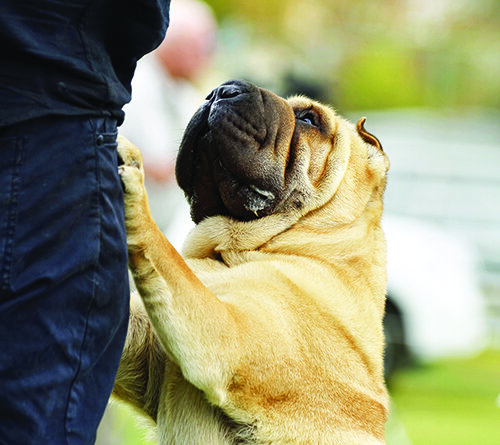Ignore at Your Peril – Whole Dog Journal
Ignoring should work, right? One of the first bits of behavior science that we pick up as dog trainers is that behavior is driven by consequences.
• If something good happens after a behavior, that behavior is likely to be repeated.
• If something bad happens, the behavior may diminish.
• And if nothing happens at all after a behavior, there’s often no point to the behavior. It may well fade away.
Those are all true statements. So if a dog greets us by jumping in the air and pounding us with his front feet, or barks demandingly as we prepare his meal, how come he doesn’t quit when we ignore the naughtiness?
KEYS TO UNDERSTANDING
When seeking to change behavior, we start by identifying and describing the behavior. Then we seek to identify the consequence that is driving the behavior. We identify antecedents: We note the situations and environments in which the behavior is likely to occur. We then create a plan to change the consequences and/or the antecedents in order to change the behavior.
I’m going to describe five reasons why “ignoring” may fail as a strategy; each corresponds to failures in a behavior-change plan. They may occur because we fail to identify the consequences that could be driving the behavior. They may occur because we misidentified the emotional state of the dog (an error in identifying an antecedent). Or they may fail because our plan was not complete or we just couldn’t carry it out. Here are five common ways the “ignoring” plan can fail:
1. Other reinforcers are present. A very common reason why ignoring fizzles as a strategy is that paying attention to the dog is not the reinforcer of the undesired behavior in the first place, or it is not the only reinforcer.
The classic example of this is the behavior of jumping to greet. Surely part of the reason a dog jumps on his owner or arriving visitors is to interact with them. It is so tempting to assume that if we remove that interaction –
if we look away, turn away, and don’t speak to him – he will quit that annoying jumping. Good luck with that, though; it rarely works by itself.
The dogs who continue to jump when ignored – what are they getting out of it? One consequence is that they get closer to our faces. We are vertical creatures and it takes a good jump to get up to where the action is!
Also, we have to consider that the behavior just may feel good to the dog, even when he’s being ignored. It’s fun for dogs to use humans as a backstop or a launching pad! Jumping may also be driven by anxiety or over-arousal.
If we use ignoring for the dog who barks demandingly for his meal, we are even more off-track. What is the ultimate reinforcer that results from meal preparation? Food!
Wise trainers pay close attention to what their dogs are doing for the period before such a big reinforcer. Barking, twirling, head butting, hand nuzzling, getting underfoot in the kitchen, and jumping can all be beautifully maintained by the presentation of a meal’s worth of food at the end of it all. You can get any of those behaviors without paying any attention to the dog. Consequently, removing the attention does nothing to decrease the behaviors.
2. People are confused about what, exactly, constitutes “ignoring.” It’s difficult to define and hard to carry out! Ignoring might work in a few more cases – if only we really knew how to do it. Also, it’s hard to define the term “to ignore” without using negatives; you don’t do this; you don’t do that . . . .
What you do is to proceed as if the dog, with her annoying behavior, is not there. That’s hard, especially if the dog is making physical contact with you. And there’s some truth to the “don’ts” in the common definition. It can take as little as a quick glance from us to connect with our dog. They are the world’s best noticers! That quick look, that “Oof” noise, that lurching body movement you might make – all those can be responses to the dog. They affected your behavior and they noticed!
And then there are the things we sometimes try to get them to stop. Turning our backs just gives them a clearer vertical surface to carom off of. Pushing them away – what a fun game! For some dogs, even being yelled at is more enjoyable than being truly ignored.
There are some dogs out there for whom certain behaviors are so driven by attention that ignoring could work. But a good trainer would use it as only part of a strategy for behavior change – and it still has to be done correctly. A great trainer friend of mine teaches her clients a targeting behavior when she implements that plan for dogs who jump. But the behavior is not for the dog; it’s for the person! She teaches her human clients to make eye contact with her (if she is present) or read a magazine (if the client is home alone). It gives them an alternative behavior so they don’t look at the dog.
But that is only a part of the training plan. The dog is learning a behavior, too. She and her client are working on reinforcing a more acceptable behavior that doesn’t include knocking down visitors.
3 We don’t ignore the dog for a sufficiently long period. Even in situations where ignoring might work, we have a hard time sticking with it long enough.
Here’s a different behavioral example: Let’s say your tiny dog has learned to get attention by pawing at your leg. Perhaps she gets picked up, petted, spoken to, or even fed from the table when she does that. How many hundreds of times has that worked for her in your life together?
Now turn it around. How many hundreds of times have your responses to her been reinforced? Hundreds! Dogs are masters of negative reinforcement. They learn to bug us until we do something, then stop (for a while). That’s how your own habit of response got built and firmed up.
It’s jarring for some of us when we realize that to change our dog’s behavior, we have to change our own. After all those repetitions, how are you going to remember never again to respond to the adorable paw-on-the-leg behavior? Perhaps you’ll blow it when you are talking on the phone or messing around on social media. There’s that little foot. You reach down and – darn! You kept the behavior alive.
Even if you are an expert at changing your own behavior, if you can make a plan and stick to it – how about the rest of your family and acquaintances? How are you going to prevent them from reinforcing the dog for that little pawing motion?
This is the situation in which we need to be careful about variable reinforcement. It may not be the best solution for building strong, reliable, cued behaviors in training, but it is fantastic for keeping annoying day-to-day behaviors alive. Variable reinforcement makes a behavior resistant to extinction. So when your dog has nothing else to do, why shouldn’t she revert to something that used to work for attention? Why not try that little paw scratch one more time? You are back where you started if you respond!
One more thing about extinction: The behavior we are trying to extinguish will generally worsen before it gets better. It will typically get more frequent or intense in what is called an extinction burst. How many times do you punch the button for a “walk” signal at an intersection you want to cross? How many times will you click on the “OK” box on the error message on your computer, even as nothing happens, before realizing your computer has frozen up? When that happens, do you ever treat your keyboard rather roughly?
When reinforcement for a behavior is abruptly removed, it can be frustrating. So with our little dog, the paw scratching may get more frequent or harder. The dog may start adding a whine. That’s often when we cave, and that has bad consequences. We just reinforced a long behavior chain of undesirable behavior instead of one little scratch.
4 The dog doesn’t know what to do instead; we’ve left her in a behavioral vacuum.
Let’s say we have correctly identified that the sole reinforcer of an annoying behavior is attention. We have learned how to ignore the behavior and been consistent at that. We have convinced every other person in the dog’s life to do the same. We still have a problem, though. We have left the dog with a void. There used to be something she could do to gain reinforcement and it’s gone. What behavior will take the place of the one we have discouraged?
Left to her own devices, the dog may come up with something worse – and who can blame her? Being ignored is hard for members of a social species. And performing a behavior that has successfully served a purpose for years without getting the expected outcome is unpleasant for anyone.
In my opinion, this can be especially hard on dogs who are otherwise untrained. Let’s say a pet owner reads an article that she should just “ignore the bad behavior” and gives it a try. But she has never used positive reinforcement in the form of food or play to train her dog. Trained dogs usually have default behaviors – behaviors they can fall back on that are desirable to humans and will earn the dog some reinforcement. They have at least some clues about what to try. But dogs who get the “ignoring” treatment when they don’t have a clue what to do instead are in an unfair, even pitiable position.
The outcome won’t likely be great for the owner, either. Since she hasn’t trained the dog to chill on a mat or crate or sit to ask for something, the dog will likely come up with a natural doggie behavior to fill the void. And it may be even less acceptable than the first one. Well-designed plans for behavior change include the teaching and reinforcing of new behaviors.
5 The dog may be too upset to care that you are ignoring him. If he’s worked up about something, he may not be able to change his behavior at that moment.
Until now, I’ve been discussing situations where the dog is not scared or overwrought. But there are whole classes of behaviors wherein the dog is undergoing a sympathetic nervous system fight or flight response. Thankfully, it’s uncommon for people to recommend that we just ignore our dogs if they lunge or pounce at another dog on-leash or stalk humans who are strange to them. But there is a common, emotion-driven behavior where ignoring is sometimes recommended: barking.
Dogs bark for so many apparent reasons. Certainly they bark purely for attention sometimes, especially if they and their owners have developed a little reinforcement cycle for it. But dogs also bark in excitement, as part of territorial aggression, and for many other reasons – including fear.
Fear barking (which mostly coincides with what people call reactivity) can be hard for we humans to identify. We may think the dog is being protective of us. Or we think that it is “fun” for a dog to run through the house to bark at the mail carrier at the door or delivery trucks on the street. We say, “It’s the highlight of her day!”
It took me two or three years to realize that my dog who used to bark in a frenzy when a delivery truck was in the neighborhood was afraid. During those couple of years of my ignorance, her triggers expanded to include a host of sounds. These included the truck engine sound, the truck doors sliding open or slamming closed, the delivery person walking onto the porch, the noise of the mailbox lid or a box hitting the porch, and (the frosting on the cake) the voice of the particular mail carrier who had loud conversations on his Bluetooth headset as he delivered our mail.
None of her barking was for attention. I know from my webcams that she did it when I was not home. And I have observed that the barking was negatively reinforced. She barked all through these scary stimuli, then the truck engine would start up or rev (another trigger) and the truck would finally leave. The aversive things were gone, and she stopped.
Since then I have helped my dog with her fear and barking via classical conditioning. But I haven’t been able to completely eliminate it, since I am not always home when trucks come by. In any case, ignoring her barking had no part in our plan.
MAKE A PLAN
I can’t present a plan that will decrease all annoying dog behaviors across the board – nobody can! That’s the problem with “ignore the dog.” It’s a one-size-fits-all solution that fits almost no situation. But we can decrease most of those nuisance behaviors with a good training plan: We need to identify the reinforcer of the behavior, identify what sets the stage for it, and aim our interventions with full knowledge of those things.
This isn’t always easy. Consider booking a lesson with a force-free trainer to keep from wasting time on non-solutions such as “just ignore the dog”!
This article was first published in Clean Run – The Magazine for Dog Agility Enthusiasts.








escitalopram and sleep